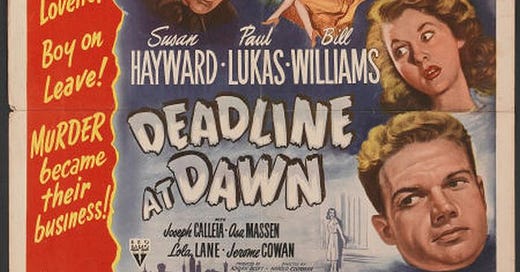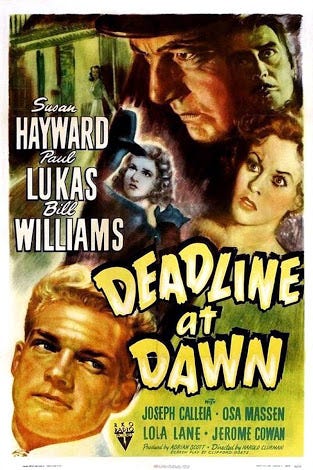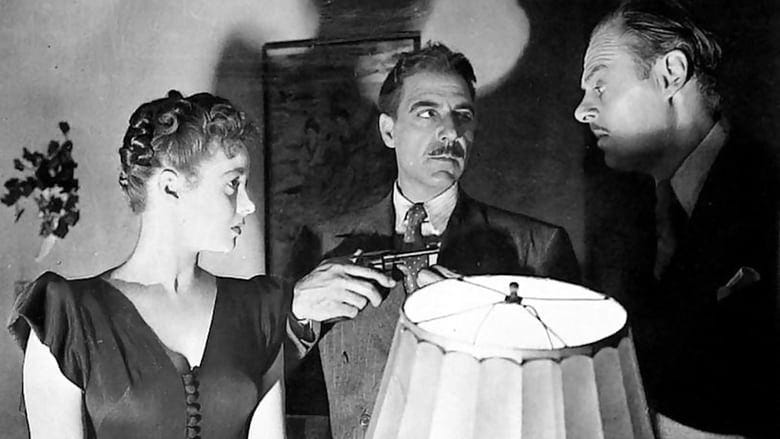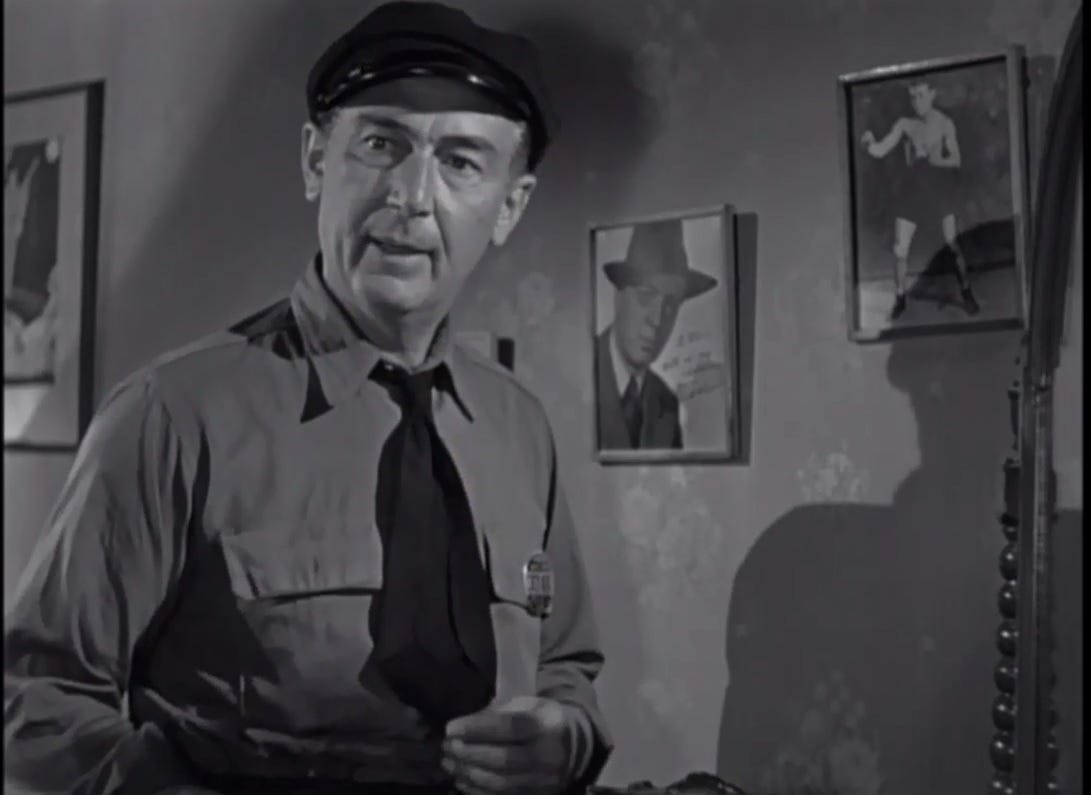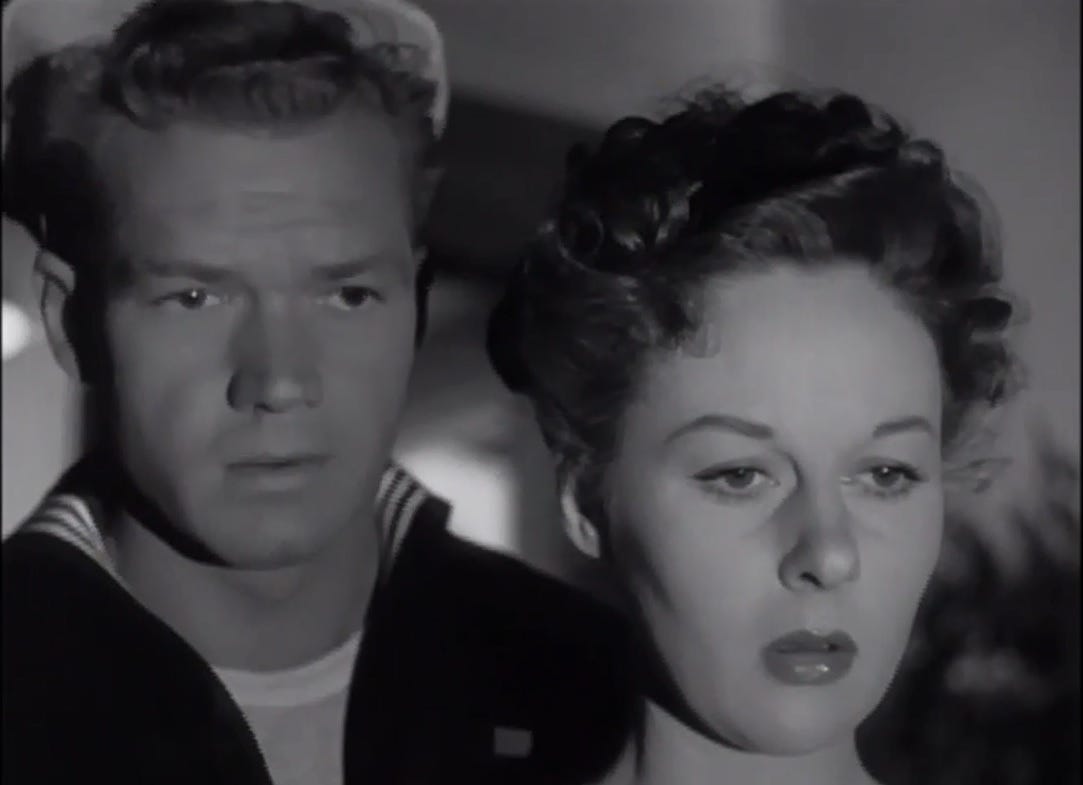Deadline at Dawn (1946, Harold Clurman)
A fun little gem that is entertaining throughout its runtime
Pulpy and fun, Deadline at Dawn is one of those easy to watch murder mysteries of the 1950s that I could definitely rewatch on a random afternoon. After getting into a fight with a brother and sister team of gamblers that rip him off, Alex, a sailor returning home from the Navy, has until dawn to piece together how the woman who tried to rip him off ended up dead and how he ended up with a bag full of money after a drunken blackout. Susan Hayward is the dance hall girl turned love interest that isn’t fully convinced Alex is a murderer and along with a philosophical cab driver played by Paul Lukas, the trio try to solve the mystery of who murdered the woman before anyone else discovers the body in the morning.
Deadline at Dawn was produced by RKO’s B unit, and fell under the auspices of the cantankerous Sid Rogell. In acclaimed director Richard Fleischer’s memoir, Just Tell Me When To Cry, he recounts sitting in an early production meeting about this film in which Rogell walked in and stated “the first thing we’re going to do today is kick the director right in the balls. You don’t have forty days to shoot the picture. You’ve got thirty.” He was soon fixated on the setups and read the first one out loud. “Exterior. Newsstand. Night. Rain,” before looking up at director Harold Clurman. “Do you know how much fucking rain costs?” and eventually asked “What do you want rain for?” “For the mood,” Clurman answered. “It’s the opening of the picture.” “Fuck the mood. No rain.” As Rogell attempted to move on, Clurman is said to have held up his hand. Fleischer said he was expecting a fight before the director resigned himself and mockingly asked “How about dust? Lots of dust blowing everywhere. Can we afford dust?”
Though it wouldn’t seem like it by the way he was treated by Rogell, Clurman is still lauded to this day as one of the pivotal figures in American theater, but he only directed only one film. Clurman was a big deal and a name on par with the likes of Lee Strasberg to drama students and fans of theater. He helped found the legendary Group Theater in New York, and remained there until its dissolution in 1937. Uta Hagen credits him with changing her perspective on acting, and he originated dozens of now classic plays on Broadway and is the namesake of the Harold Clurman Theater on Theater Row in New York City. Many of his personal writings are now kept as part of the Stella Adler and Harold Clurman Collection at the University of Texas at Austin.
Despite not actually using any New York City locations, with RKO opting instead to shoot on their own backlots rather than on location, Deadline at Dawn has a very New York feel. That’s because director Harold Clurman and Cornell Woolrich, who wrote the 1944 novel were both born and raised in New York City, while screenwriter Clifford Odets was born in Philadelphia and raised in The Bronx. Odets dropped out of school and went out on his own at the age of 19, and got himself booked in the 1920s on the radio as an expert elocutionist. He joined the Theatre Guild in 1929, where he soon formed a friendship with the legendary Cheryl Crawford, who suggested him to Clurman and Lee Strasberg, and he became one of the actors chosen to become a founding member of the Group Theater in 1931. By 1936 Odets was in Hollywood, with his first screenplay being The General Died at Dawn starring Gary Cooper. He would go on to write the screenplay for None But the Lonely Heart, starring Cary Grant and Ethyl Barrymore, who would win Best Actress. No doubt his association with Clurman aided in his being hired for this adaptation of Woolrich’s novel, and he would go on to write many more screenplays, most notably Sweet Smell of Success, the 1957 noir starring Burt Lancaster and Tony Curtis.
Like the film’s screenwriter, Cornell Woolrich dropped out of school to pursue writing and found himself becoming one of the most prolific authors in the noir, crime, and horror genres. His novels have been adapted for films not only by the likes of Francois Truffaut (The Bride Wore Black and Mississippi Mermaid), Alfred Hitchcock (The Rear Window), Robert Siodmak (The Phantom Lady), and Jacques Tourneur, but also B movie legends like Leon Klimovsky (The Earring), Umberto Lenzi (Seven Blood-Stained Orchids), William Castle (Mark of the Whistler), and Tobe Hooper (I’m Dangerous Tonight). The contributions his novels made to cinema in the twentieth century can not be overstated. Seeing “Based on a novel by Cornell Woolrich” show up as a credit on a film still perks me up as he is one of the masters of the noir genre.
This is the first starring role for Bill Williams, playing Alex with likable naiveté opposite Susan Hayward, who had already taken on starring roles with the likes of Frederic March (I Married A Witch), John Wayne (Reap the Wind), and Ingrid Bergman (Adam Had Four Sons). He was the father of actor William Katt (Tommy Ross in Carrie), and went on to stardom on television in The Adventures of Kit Carson. He also originated the role of Federal Agent Martin Flaherty in the pilot film of The Untouchables before the role was recast. He turned down the role in Sea Hunt, which would launch the career of Lloyd Bridges. He would go on to become a journeyman actor, appearing in roles on television (including many episodes of Perry Mason) and low budget science fiction films until his retirement in 1981. As told by Eddie Muller, a noir double bill was hosted shortly before Barbara Hale (Williams’ wife) death, which she attended. Moments after Deadline at Dawn began, Hale began bawling at the sight of her late husband. When she was escorted to the green room, she was heard repeating “I just love that guy so much.”
Susan Hayward was on the rise at this point in her career, though the peak of her superstardom was a few years away in the 1950s. She had begun as a model and lost out on the role of Scarlett O’Hara. She signed on with Paramount where she had her breakout role in Beau Geste with Gary Cooper and Ray Milland. Pairing her up with all these screen legends helped build Hayward up, but it was her association with Walter Wanger that really skyrocketed her career. A year after this film, she would receive the first of her five Academy Award nominations in Smash-Up, the Story of a Woman, a role that solidified her as a star with audiences. She would later sign with 20th Century Fox, where she was again teamed with Edward G. Robinson in one of my personal favorite films of hers, Joseph Mankiewicz’s House of Strangers. A few years later, she starred in three huge hits in With A Song in My Heart, for which she was again nominated for an Academy Award, and alongside Gregory Peck in two films, The Snows of Kilimanjaro and David and Bathsheba, solidifying her as one of the biggest stars of the 1950s.
By this point in his career, Paul Lukas was already a well established and decorated veteran of both the stage and screen. He won the Academy Award for Best Actor just two years prior starring opposite Bette Davis as Kurt Mueller, a role he had originated on the stage, in Watch on the Rhine. A few years after this film, he would originate the role of Cosmo Constantine in Irving Berlin’s Call Me Madame with Ethel Merman. He would work well into the 1960s, the best known of those films probably being Fun in Acapulco, in which he co-starred alongside Elvis Presley and Ursula Andress. He died in Tangier in 1971.
Though not very well known, Deadline at Dawn is a fun little gem that is entertaining throughout its runtime thanks to all its twists and turns and the performances of its three leads. Its vibe makes it the kind of film that wouldn’t feel out of place if it were remade as a pulpy crime thriller in the mid 90s.

